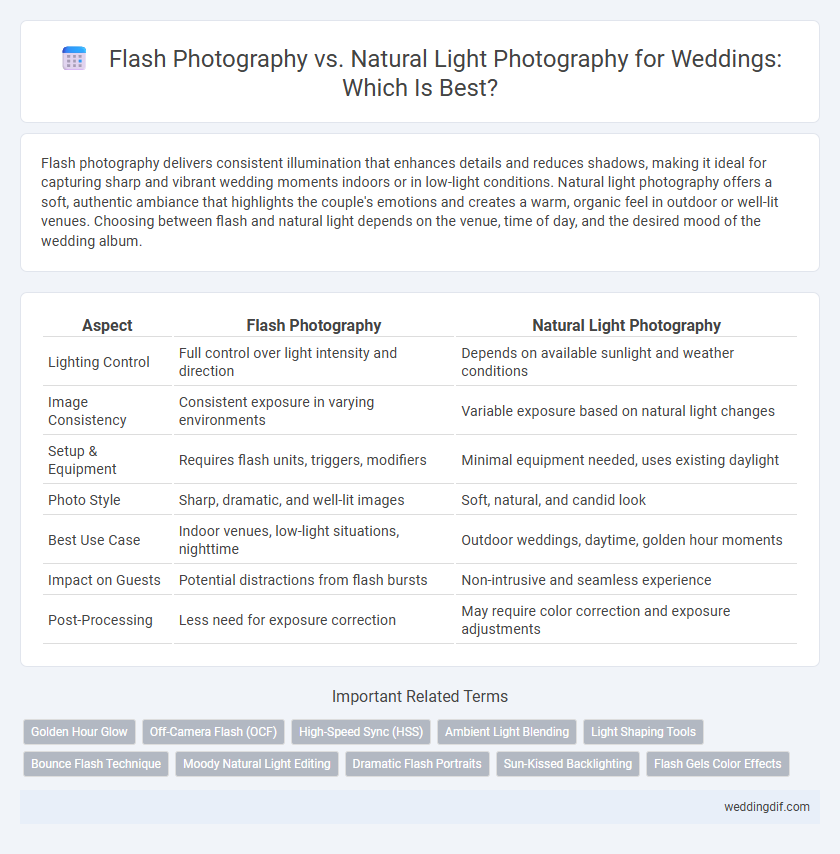Flash photography delivers consistent illumination that enhances details and reduces shadows, making it ideal for capturing sharp and vibrant wedding moments indoors or in low-light conditions. Natural light photography offers a soft, authentic ambiance that highlights the couple's emotions and creates a warm, organic feel in outdoor or well-lit venues. Choosing between flash and natural light depends on the venue, time of day, and the desired mood of the wedding album.
Table of Comparison
| Aspect | Flash Photography | Natural Light Photography |
|---|---|---|
| Lighting Control | Full control over light intensity and direction | Depends on available sunlight and weather conditions |
| Image Consistency | Consistent exposure in varying environments | Variable exposure based on natural light changes |
| Setup & Equipment | Requires flash units, triggers, modifiers | Minimal equipment needed, uses existing daylight |
| Photo Style | Sharp, dramatic, and well-lit images | Soft, natural, and candid look |
| Best Use Case | Indoor venues, low-light situations, nighttime | Outdoor weddings, daytime, golden hour moments |
| Impact on Guests | Potential distractions from flash bursts | Non-intrusive and seamless experience |
| Post-Processing | Less need for exposure correction | May require color correction and exposure adjustments |
Introduction to Wedding Photography Lighting
Wedding photography lighting significantly influences image quality and mood, with flash photography offering controlled illumination and the ability to freeze motion in low-light settings. Natural light photography, favored for its soft, authentic ambiance, relies on ambient sunlight to create organic, warm tones and dynamic shadows. Balancing flash and natural light techniques enables photographers to capture diverse wedding moments with clarity and emotional depth.
What is Flash Photography in Weddings?
Flash photography in weddings involves using artificial light sources, such as external flashes or speedlights, to illuminate subjects and scenes, ensuring consistent exposure regardless of ambient lighting conditions. This technique helps capture sharp, well-lit images even in low-light environments, such as dimly lit venues or nighttime ceremonies. Professional photographers often use flash to enhance details, reduce shadows, and create dynamic compositions while maintaining a natural look.
Understanding Natural Light Photography
Natural light photography in weddings captures authentic moments by utilizing ambient sunlight, which enhances skin tones and creates soft, natural shadows without artificial interference. Mastering natural light involves understanding the direction, quality, and color temperature of sunlight to optimize composition during different times of day. Photographers prefer natural light for its ability to produce vibrant, timeless images that require minimal post-processing while maintaining the wedding's genuine atmosphere.
Pros of Flash Photography for Weddings
Flash photography provides consistent and controllable lighting, ensuring perfect exposure even in dim or challenging indoor wedding venues. It enhances details and reduces shadows, allowing photographers to capture sharp, vibrant images regardless of ambient light conditions. The use of flash also enables creative effects and highlights, adding depth and dimension to wedding portraits and candid moments.
Benefits of Natural Light in Wedding Photography
Natural light photography in weddings captures authentic moments with soft, flattering illumination that enhances skin tones and creates a warm, romantic atmosphere. It enables a more flexible and spontaneous shooting style by avoiding harsh shadows and artificial light setups often required in flash photography. Utilizing natural light also reduces reliance on bulky equipment, allowing photographers to blend seamlessly into the wedding environment and produce timeless, elegant images.
Challenges of Flash Photography at Weddings
Flash photography at weddings can cause harsh shadows and unnatural skin tones, making it challenging to capture authentic moments. The unpredictability of flash power and timing may lead to overexposed or underexposed images, especially in dynamic wedding settings. Managing flash reflections on shiny surfaces and avoiding guests' discomfort from sudden bright flashes require technical skill and careful coordination.
Limitations of Natural Light Photography
Natural light photography for weddings often faces limitations such as inconsistent lighting conditions due to weather changes or the time of day, which can affect the quality and mood of the images. Shadows and highlights may be difficult to control, leading to uneven exposure in outdoor or indoor settings without sufficient ambient light. Unlike flash photography, natural light can restrict shooting options in low-light environments like evening receptions or dimly lit venues, potentially compromising the capture of key moments.
Comparing Image Quality: Flash vs Natural Light
Flash photography offers controlled, consistent lighting that reduces shadows and captures sharp details, making it ideal for dim or unpredictable settings during weddings. Natural light photography provides a softer, more authentic ambiance with rich, warm tones but can be challenging in low-light situations or harsh midday sun. Choosing between flash and natural light impacts image quality by balancing clarity and atmosphere depending on venue conditions and desired aesthetic.
Choosing the Right Lighting for Your Wedding Style
Flash photography offers precise control over exposure and highlights, ideal for capturing sharp moments in dimly lit venues or evening weddings. Natural light photography enhances the soft, authentic ambiance of outdoor ceremonies and daytime receptions, creating a timeless and organic aesthetic. Selecting the right lighting depends on the wedding environment, desired mood, and photographer's expertise to ensure vivid, emotionally resonant images.
Tips for Blending Flash and Natural Light Techniques
Balancing flash and natural light in wedding photography enhances image depth and mood, with key tips including using flash as a subtle fill light to reduce harsh shadows and maintaining natural light to preserve ambient atmosphere. Adjusting flash power to complement existing light and positioning off-camera flashes strategically helps create soft, flattering illumination. Experimenting with white balance settings ensures color consistency, enabling seamless integration of both lighting techniques for dynamic, professional results.
Flash Photography vs Natural Light Photography for weddings Infographic

 weddingdif.com
weddingdif.com